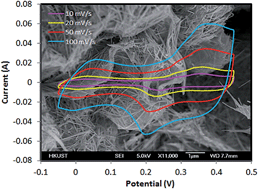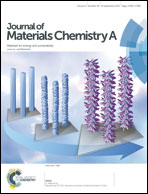Controlled synthesis of cobalt carbonate/graphene composites with excellent supercapacitive performance and pseudocapacitive characteristics†
Abstract
Cobalt carbonate hydroxide/graphene aerogel and cobalt carbonate/graphene aerogel (CCH/GA and CC/GA) composites are synthesized as supercapacitor electrodes via a one-pot hydrothermal method. Optimized processing conditions are established by controlling the composite composition and microstructure, and their influence on the capacitance performance of the electrodes is identified. A remarkable specific capacitance of 1134 F g−1 at a current density of 1 A g−1 is obtained for the optimal nanowire-shaped CCH/GA electrode, which is among the highest capacitance values of cobalt compound electrodes with or without nanocarbons reported so far. The electrode also delivers exceptional rate performance and cyclic stability benefiting from the pseudocapacitive characteristics of CC-based active materials and the highly conductive, interconnected 3D-structured GA. The CC/GA electrode presents a high capacity of 731 F g−1 under the same conditions. The ex situ XPS analysis identifies the reversible redox reactions of cobalt cations during charge/discharge cycles as the electrochemical mechanism responsible for the high pseudocapacitive properties of CC-based electrodes.


 Please wait while we load your content...
Please wait while we load your content...